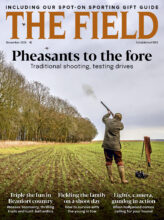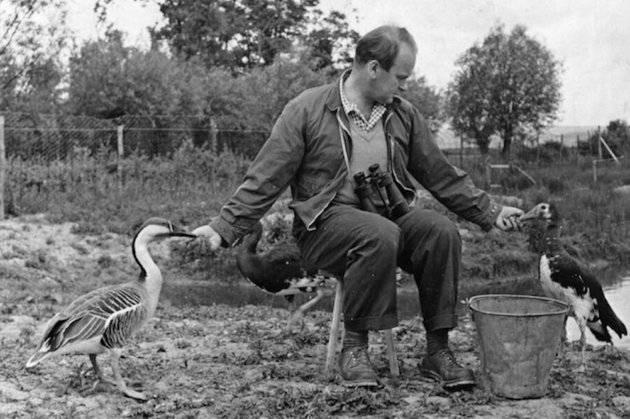Sir Peter Scott's love for wildfowl and the wetlands they depend on began on the marsh with gun in hand, says Sir Johnny Scott
The renowned wildlife artist, author, international competitor in skating, sailing and gliding, wildfowler and broadcaster Sir Peter Scott became the father of modern conservation, founding the Wildfowl & Wetlands Trust in 1946.
He was born in 1909, the only child of Captain Robert Falcon Scott, the celebrated polar explorer, and his wife, the artist and socialite Kathleen Bruce (read Will Gow’s exploration to the South Pole). Scott never knew his father, who left when he was only a few months old on the ill fated Terra Nova expedition to the South Pole in 1910, perishing two years later. A last letter from the Antarctic encouraged his wife to ‘make the boy interested in natural history’ and Scott’s early mentors included Sir Ray Lankester, former director of the Natural History Museum, and his two godfathers: JM Barrie, author of Peter Pan, and Sir Clements Markham, past president of the Royal Geographical Society, who had supported his father’s polar expeditions.
Bloomsbury Group
Sir Peter Scott grew up in London, where his mother and stepfather Hilton Young (later Lord Kennet) were members of the Bloomsbury Group. His first real encounter with the natural world was as an undergraduate at Cambridge in 1927, when he was invited to spend a day shooting on the Ouse Washes. Drawn to the mystique of the saltmarshes, Scott developed a growing passion for wildfowling and punt-gunning. After leaving Cambridge in 1930, he studied fine art for several months at the Akademie der Bildenden Künste in Munich, followed by two years at the Royal Academy of Arts in London, before renting the East Bank lighthouse at the mouth of the River Nene. This he used as a base to write and paint, as well as for wildfowling forays in the Wash.
Other famous wildfowlers who befriended Scott included James Robertson Justice, who became a well-known actor; Keith ‘Toby’ Bromley, of the footwear chain; and Kenzie Thorpe, a local poacher, fen guide and wildfowler immortalised in Colin Willock’s book Kenzie, the Wild- Goose Man. Thorpe taught him more about species identification and the seasonal movements of migratory waterfowl than anyone else and, in exchange, Scott encouraged Thorpe to paint. During his time in Lincolnshire, Scott had a wellreceived exhibition of his own paintings; wrote two outstanding and evocative books on wildfowling – Morning Flight and Wild Chorus; established a collection of wildfowl at the lighthouse, including different species of white-fronted geese; won a bronze medal for sailing in the 1936 Olympics; and made several expeditions abroad, combining the study of wild geese with wildfowling.
Mentioned in despatches
During the Second World War Scott served with the Royal Naval Volunteer Reserve and was mentioned in despatches three times, awarded the Distinguished Service Medal and bar ‘for skill and gallantry in action with enemy light forces’, and the MBE for designing a camouflage scheme that disguised the superstructure of warships. With the war over, Scott moved operations to Slimbridge on the banks of the Severn, where a flock of white-fronted geese traditionally overwintered. Here he set up the Severn Wildfowl Trust (SWT) with, among others, his friend Robertson Justice as a founder member.
Conservation aims
The aim for the Trust was to be a centre for the scientific study, public display and conservation of wildfowl, with Scott as its director. Within five years, one of the largest collections of wildfowl in the world was assembled at Slimbridge, including the endangered Hawaiian goose. Scott was still shooting at this stage, and there are accounts of fowling trips to Hungary and the Wexford Slobs in Ireland. However, as the SWT expanded to become the Wildfowl & Wetlands Trust (WWT), and an advisory panel formed of internationally distinguished scientists, his involvement in fieldsports was considered incompatible with the conservation aims of the Trust.
A man of enormous energy, Scott was extremely active in the years following the formation of the WWT, leading ornithological expeditions worldwide and bird-ringing teams to the subarctic to catch and ring geese when flightless during the annual moult. He was a founding member of the World Wide Fund for Nature, influenced a shift in policy of the International Whaling Commission and played a pivotal role in the signing of the Antarctic Treaty. A confident and charismatic broadcaster, he presented the BBC natural history series Look between 1955 and 1969, which helped popularise interest in wildfowl and wetlands preservation. He wrote several books, including his autobiography; maintained a steady output of wildlife paintings; took up gliding in 1956, becoming British Champion in 1963; and the following year skippered the 12-metre yacht Sovereign in the America’s Cup.
Sir Peter Scott knighted
Scott was knighted in 1973 for his contribution to conservation, and between 1946 and his death in 1989 accumulated more than 40 honours, awards and appointments, including eight honorary degrees. Since the original WWT reserve was created at Slimbridge, nine other sites have been established in West Sussex, Dumfries and Galloway, County Down, Tyne and Wear, London, Carmarthenshire, Lancashire, Somerset and Norfolk, and the Trust advocates for wetlands and conservation issues worldwide. He was a remarkable man who, through sheer force of personality, left an incredible legacy for the benefit of all mankind.





